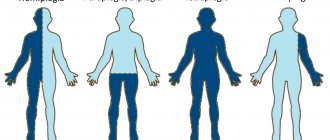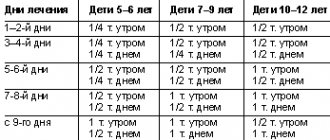Classification of hypersomnia
The classification of this pathology depends on the cause of its development. Based on the etiology, the following types of hypersomnia are distinguished:
- post-traumatic;
- psychophysiological;
- psychopathic;
- idiopathic;
- narcolepsy;
- associated with respiratory dysfunction during sleep and various somatic diseases.
According to clinical features, paroxysmal and permanent hypersomnia are distinguished. A feature of the paroxysmal form of this disease will be sudden attacks of drowsiness, regardless of external factors and circumstances. The phenomenon of paroxysmal hypersomnia is often a sign of cataplexy or narcolepsy. With permanent hypersomnia, patients complain of drowsiness and constant drowsiness during the day.
Causes
The state of wakefulness and sleep in humans is regulated by a complex system of interconnected structures located in the cerebral cortex, subcortical formations, limbic system, and reticular formation. They activate and inhibit brain activity. Hypersomnia is formed due to the presence of malfunctions in the functioning of this system. It is due to the following reasons:
- Psychophysiological. It occurs in healthy people with prolonged lack of sleep, physical and mental fatigue, and also after stressful situations.
- Medication. It is associated with taking a number of medications (hypotensives, neuroleptics, tranquilizers, antihistamines, hypoglycemic drugs).
- Post-traumatic. This form occurs due to functional disorders of the central nervous system. Its development is possible after an episode of traumatic brain injury. It develops with organic brain lesions, such as: brain abscess, intracerebral tumor, intracerebral hematoma, infections of the nervous system (meningitis, neurosyphilis, encephalitis), vascular pathologies (hemorrhagic stroke, chronic ischemia, ischemic stroke).
- Occurs in mental disorders. Hypersomnia is a symptom of narcolepsy and cataplexy. It is less commonly observed in neurasthenia, schizophrenia and other diseases.
- Somatically conditioned. Occurs in certain somatic pathologies (diabetes mellitus, hypothyroidism, liver cirrhosis, heart failure, chronic renal failure).
- Idiopathic. Increased drowsiness develops in the patient without any particular reason. In this case, there is no connection with any disease.
Most types of hypersomnia are associated with breathing disorders during sleep. They predominantly develop due to chronic hypoxia in brain tissue.
Causes of hypersomnia
There are many reasons why this pathological condition develops.
Most often, the main etiological factors will be:
- various neurological, somatic, mental diseases;
- sleep phenomena (motor disorders during sleep, sleep apnea syndrome);
- traumatic head injuries;
- circadian rhythm disorder (as a result of transtemporal flights, shift work schedule);
- adverse events after taking medications;
- insomnia (insomnia), etc.
The cause of psychophysiological hypersomnia, as a rule, will be lack of sleep at night, so it can be observed in healthy people and is easily eliminated by normalizing the rhythm of life, as well as minimizing mental stress.
According to studies of the mechanism and causes of hypersomnia, it is known that most often it occurs against the background of narcolepsy. Narcolepsy often occurs as a result of an existing genetic disorder. In this case, expressive daytime drowsiness and episodes of involuntary, sort of forced, falling asleep occur.
- Quite often, hypersomnic conditions can occur due to neurological dysfunction. The most unpredictable course of increased sleepiness is the clinic of hysteria. With this disease, pathological sleep can last for a very long time, in some cases several days.
- Manifestations of hypersomnia associated with mild brain injuries are difficult to distinguish from clinical manifestations of mental disorders. Differential diagnosis consists of identifying pronounced structural changes in the brain that appear as a result of injury. The absence of such damage in hypersomnia indicates that the cause of this pathological condition will not be brain damage, but a stressful state caused by trauma.
- Another cause of hypersomnia can be depressive disorders.
- In some cases, drug therapy for various diseases becomes the cause of drug-induced hypersomnia; in particular, this form of increased drowsiness is included in the list of side effects when using some antihypertensive, hypoglycemic and psychotropic drugs.
- Insufficient duration of sleep at night against the background of insomnia, dysfunction of circulatory rhythms caused by shift work and various external factors often provokes sleep disturbances and the development of a hypersomnic state.
Based on the above, it is clear that hypersomnia has a polyetiological nature, and its diagnosis requires a systematic approach.
Idiopathic hypersomnia
Idiopathic hypersomnia has historically been “difficult to diagnose early,” especially because many other disorders can cause symptoms of excessive daytime sleepiness (EDS). Thus, "at the time of recognition, many patients had suffered from this disorder for many years." What makes diagnosis even more difficult is that idiopathic hypersomnia has no clear clinical manifestations. While narcolepsy is associated with cataplexy and episodic REM sleep, and Klein-Levin syndrome is associated with megaphagia (compulsive food cravings) and hypersexuality, idiopathic hypersomnia does not present as such overt symptoms other than perhaps drunken sleep. “Consequently, there is a tendency to label all difficult-to-classify cases of excessive daytime sleepiness as idiopathic hypersomnia.” For example, right airway resistance syndrome and delayed sleep phase disorder were previously confused with idiopathic hypersomnia, but they are now better understood and so doctors can more confidently rule out these causes of EDS in order to better identify idiopathic hypersomnia. However, “even in the presence of other specific causes of hypersomnia, the influence of these etiological factors causing EDS should be carefully assessed, and when all specific treatments for EDS fail to suppress it, these manifestations should be considered idiopathic hypersomnia” 14). The severity of EDS can be quantified using subjective scales, such as the Epworth Sleepiness Scale or the Stanford Sleepiness Scale (SSS), as well as objective tests, including sleep latency testing.” In 2011, the International Classification of Sleep Disorders (ICDS) updated its criteria for diagnosing idiopathic hypersomnia. Essentially, EDS must last for at least 6 months, sleep studies (polysomnography and sleep latency testing) must show specific features, and all other known causes of long sleep time and EDS must be considered. For the patient, the diagnostic process is very tedious, costly and time-consuming because, unlike other sleep disorders, this disease is determined by exclusion. In patients with idiopathic hypersomnia, polysomnography typically shows short sleep latency, increased slow-wave sleep, and high mid-phase sleep efficiency. “REM sleep latency and the percentages of light sleep and REM sleep were normal when compared with normative values.” It is important to note that although sleep latencies are typically short in idiopathic hypersomnia, clinical severity may not correlate closely with sleep latency testing results. In fact, "latencies greater than 5 minutes are not uncommon in patients with clinically severe hypersomnia." With sleep latency less than 10 minutes, the presence of REM sleep episodes two or more times on sleep latency testing is suggestive of narcolepsy, while periods of non-rapid eye movement sleep suggest a diagnosis of idiopathic hypersomnia. However, the importance of differentiating REM sleep from rapid eye movement sleep has been questioned (see Classification section). Although sleep latency testing represents the best test for diagnosing EDS in general, the sleep latency testing protocol lacks the ability to document extended, non-refreshing daytime sleep onsets that often occur in idiopathic hypersomnia. Complicating the original findings, several groups of researchers have found normal sleep latency testing results in patients who appear to have idiopathic hypersomnia. Therefore, when idiopathic hypersomnia is suspected, researchers suggest using continuous 24-hour polysomnography as part of a standard overnight sleep latency test to determine total sleep duration. In addition, cerebrospinal fluid (CSF) analysis may also be performed to check for the presence of adequate hypocretin levels (to rule out narcolepsy with cataplexy) and to determine if CSF is causing an abnormal increase in GABA receptor sensitivity (thought to underlie many cases of idiopathic hypersomnia and narcolepsy without cataplexy). In general, there are very few laboratories that are capable of performing this type of cerebrospinal fluid analysis. It is also important to note that while narcolepsy is strongly associated with the HLA-DQB1*0602 genotype, “HLA typing will not assist in the positive diagnosis of idiopathic hypersomnia.” This occurs "despite some reports suggesting increased frequency of HLA Cw2 and DRS in subjects with idiopathic hypersomnia."
Clinical signs of hypersomnia
The clinical manifestations of this pathology are directly related to the etiological prerequisites. However, among all the signs of hypersomnia, its main symptoms are highlighted, which are represented by periodic or stable sleepiness during the day and a long duration of sleep at night. Typically, nighttime sleep with hypersomnia takes 12-14 hours. Patients often complain of difficulty waking up, lack of response to alarm clocks, and an increase in the period from a sleepy state to full awakening. Therefore, some time after waking up, patients with hypersomnia may feel lethargic and drowsy. This condition resembles a clinic of intoxication; it is also sometimes found in the medical literature under the wording “sleepy intoxication.”
The phenomenon of daytime sleepiness, regardless of its nature, is often accompanied by a decrease in performance and attentiveness, which ultimately disrupts normal work activity, provokes a disruption in the normal rhythm of life and forces people to interrupt sleep during the daytime. Sometimes, after a daytime nap, patients may notice a relief in their general condition, but in the majority of cases, drowsiness remains the same.
What is hypersomnia?
People with hypersomnia do not feel rested when waking up, even after a long sleep. They may have an overwhelming urge to sleep at any time, including at work or while eating. People with a disorder called idiopathic hypersomnia typically sleep more than 11 hours a night and have difficulty waking up. This type of behavior often has a significant impact on social, family and work life. Depending on the type of hypersomnia, it may first appear in adolescence and early adulthood and may require lifelong treatment. Hypersomnia can be either primary or secondary.
Primary hypersomnia
is a condition that affects the central nervous system and directly affects sleep itself. Examples are narcolepsy, idiopathic hypersomnia, and Kleine-Levin syndrome.
Secondary hypersomnia
is a condition in which excessive sleepiness is caused by another condition or disease. Examples include:
- lack of sleep
- a sleep disorder that fragments sleep, such as sleep apnea
- head injury or other neurological disorder such as Parkinson's disease
- medical disorder
- certain medications, including opiates, benzodiazepines, antipsychotics, and antihistamines
Additional symptoms
In addition to the main symptoms, there are a number of clinical manifestations characteristic of certain diseases that cause hypersomnia. For example, with narcolepsy, patients may experience irresistible drowsiness and fall asleep even at the most inopportune moments. Over time, patients begin to sense in advance the approach of these attacks of forced drowsiness and take the most comfortable sleeping positions. Symptoms of this form of pathologically increased sleepiness also include hallucinations at the moments of falling asleep or waking up and awakening cataplexy, which is characterized by atony of the muscular system, as a result of which the patient loses the ability to carry out any movements for several minutes after waking up.
Psychopathic hypersomnia is characterized by an unpredictable nature of daytime sleepiness, the features of which are determined by specific psychopathology. Sleep can be quite long, but the results of a polysomnographic study indicate that the patient’s body is not in a state of sleep, and intense wakefulness is often detected on the electroecephalogram.
The phenomenon of idiopathic hypersomnia is most often characteristic of persons from 15 to 30 years old. This form of hypersomnia is manifested by difficulty waking up, constant drowsiness, in some cases, patients experience ambulatory automatism for several seconds.
If the reticular formation is damaged, as well as with epidemic encephalitis, lethargic sleep may develop, which is continuous sleep for 24 hours or more.
Environmental influence
Stressful or tragic events in life can cause insomnia. Shift work, as well as changes in time zones or changes in altitude, can disrupt the sleep cycle. Sleep deprivation can occur as a result of an excessively warm environment during sleep or environmental noise.
Approximately one third of all Americans experience a sleep disorder at some point in their lives. Between 20% and 40% of adults report sleep problems at some point each year, and about 17% of adults consider their sleep problems to be a serious problem. Sleep disorders are a common reason for patients visiting medical institutions. Approximately one third of the adult population has chronic sleep deprivation syndrome. Twenty percent of adults report chronic insomnia.
Increasing age predisposes to sleep disturbances (5% of cases in those aged 30-50 years and 30% in those aged 50 years and older). Older adults report a decrease in total sleep time, with more frequent awakenings during the night. Older people are also more likely to have medical illnesses and take various medications, which can lead to sleep disturbances.
Primary insomnia is more common in women, with a female to male ratio of 3:2. Hormonal changes during the menstrual cycle or during menopause can lead to disruptions in sleep patterns. Obstructive sleep apnea syndrome (OSA) is more common in men (4%) than in women (2.5%).
The prognosis varies widely, depending on the cause of insomnia or other sleep disorders. For example, insomnia due to sleep apnea resolves with effective sleep apnea treatment, while insomnia due to refractory major depression may be persistent because depression is not always successfully treated.
Chronic insomnia is associated with an increased risk of depression and the associated risk of suicide, anxiety, decreased ability to work, decreased quality of life, and increased healthcare burden.
Insufficient sleep can lead to industrial and automobile accidents, physical symptoms, cognitive dysfunction, depression, and decreased daytime performance due to fatigue or drowsiness.
Insomnia may manifest itself as decreased sleep efficiency or a decrease in total hours of sleep, with some associated decrease in productivity or well-being. Because sleep needs vary from person to person, the quality of sleep is more important than the total number of hours of sleep. The total number of hours of sleep should be compared with each person's normal nightly sleep time over the course of a lifetime.
Initial insomnia (also known as early-onset insomnia) is characterized by difficulty falling asleep, with an increase in sleep latency (ie, the time between going to sleep and falling asleep). Initial insomnia is often associated with anxiety disorders.
Moderate insomnia is characterized by difficulty maintaining sleep. There is a decrease in sleep efficiency, fragmented, restless sleep, frequent awakenings during the night. Moderate insomnia can be associated with somatic diseases, pain syndromes or depression.
Late insomnia is characterized by early awakening, and patients consistently get up earlier than necessary. This symptom is often associated with major depression.
Changes in your sleep-wake cycle can be a sign of circadian rhythm disorders, such as those caused by jet lag or job changes.
Hypersomnia, or excessive daytime sleepiness, is often associated with prolonged sleep deprivation or poor sleep quality due to a variety of reasons, ranging from sleep apnea to substance abuse or underlying medical conditions.
Sleepwalking, also called somnambulism, is characterized by complex episodes of behavior that occur during the slow phase of sleep and the patient forgets what happened.
Nightmares recur after awakening from sleep, and are associated with vivid impressions of nightmares. Nightmares usually occur in the second half of the sleep period. After waking up from sleep, a person quickly begins to navigate in real time and space.
Night terrors are characterized by repeated episodes of abrupt awakening from sleep with intense fear, panicked screaming, and autonomic arousal. The individual, as a rule, does not remember the details of the dream. Night terrors occur during the first third of the night, during stages 3 and 4 of non-REM sleep.
Diagnosis of hypersomnia
Making a correct diagnosis for hypersomnia requires a complex of diagnostic procedures, since it is very important to clarify the form of hypersomnia and its etiology; this is the only way to prescribe appropriate therapy. Therefore, in addition to a standard neurological examination and history taking, a number of additional studies may be required, and in some cases it is advisable to involve additional specialists (traumatologist, psychiatrist, ophthalmologist, cardiologist, gastroenterologist).
In the process of collecting anamnesis, attention is focused on the presence of genetic diseases, recent head injuries, concomitant pathologies, as well as the general rhythm of life of the patient.
Additional methods for studying hypersomnia include specific tests (sleep latency test, Stanford School of Sleepiness).
An important diagnostic role in identifying pathologically increased sleepiness is to perform a polysomnographic study. Polysomnography allows you to clarify the form and features of the clinical course of hypersomnia.
It is also important to differentiate hyposomnia, which has developed against the background of other pathologies, from increased drowsiness with an organic etiology (as a result of asthenia, chronic fatigue syndrome, depression), since this is the only way to prescribe optimal therapy. Such differentiation often involves echo-EG, CT of the brain, ophthalmoscopy, etc.
Hypersomnia: causes of the disease, main symptoms, treatment and prevention
Constant drowsiness with sufficient duration of sleep at night can be caused by injuries and pathologies of the brain, side effects of medications.
Causes of hypersomnia
The occurrence of the disease may be a reaction to taking certain medications. This is also how CNS (central nervous system) disorders can manifest themselves. Increased drowsiness can occur against the background of pre-existing diseases (pathological conditions of the brain, vascular disorders, infections).
Symptoms of hypersomnia
The disease is characterized by one main feature - a drowsy state during the day, occurring periodically, in bursts, or constantly during the normal duration of night sleep.
Diagnosis of hypersomnia
The diagnosis is established after a comprehensive examination and consultation with several specialists to exclude the presence of other pathologies or to identify a disease leading to hypersomnia. An MRI or CT scan of the brain, examination by an ophthalmologist and ophthalmoscopy are recommended. Consultations with an endocrinologist, cardiologist, and nephrologist may be necessary. The main commonly accepted tests are the Stanford Sleepiness Scale and the Sleep Latency Test. Polysomnography is also important in diagnosing the disease. Provided that all examinations have been completed and the patient’s condition remains the same for a month, the neurologist diagnoses “hypersomnia.”
Treatment of hypersomnia
As a rule, hypersomnia is a companion to the underlying disease and therapy is aimed at eliminating its manifestations. Be sure to strictly adhere to the sleep and wakefulness regime, as well as eat rationally, do not abuse alcohol and fatty, heavy foods in the evening hours before bedtime. Night sleep should not exceed nine hours. If possible, evening work and night shifts should be avoided. It is possible to use stimulants to combat daytime sleepiness (Pemoline, Modafinil, Propranolol). It is recommended to exclude driving personal vehicles for the period of treatment.
Prevention of hypersomnia
Prevention lies, first of all, in paying close attention to your own health. It is necessary to try to avoid stressful situations and excessive physical activity. It is advisable to promptly treat diseases that can cause hypersomnia, especially paying attention to pathologies of the central nervous system. If you lack sleep, it is recommended to regulate your sleep and wakefulness patterns.
Treatment of hypersomnia
Treatment of hypersomnia has a direct relationship with the accuracy of diagnostic results and elimination of the underlying disease. In some cases, the disease that causes hypersomnia cannot be completely cured, then therapeutic tactics are aimed at minimizing symptoms that negatively affect the patient’s quality of life.
An important point in the fight against this pathological condition will be the normalization of sleep patterns. Patients need to abandon the daily work schedule and go to bed at the same time. You also need to include 1-2 times of daytime sleep in your daily schedule, while the duration of night sleep should not be more than 9 hours. To achieve positive results in the treatment of hypersomnia, it is necessary to stop drinking alcohol, exclude heavy foods from the diet (too fatty, smoked) and try to avoid eating immediately before going to bed.
Drug therapy for a hypersomnic state involves the use of the following stimulant drugs:
- propranolol;
- modafinil;
- dextroamphitamine;
- mazindol.
For cataplexy phenomena, patients are prescribed antidepressants:
- viloxazine;
- clomipramine;
- protriptyline;
- fluoxetine, etc.
After all therapeutic measures have been implemented, the patient must be provided with dynamic monitoring, since hypersomnia is prone to relapses.
Prognosis of hypersomnia
The prognosis, as well as the treatment of a hypersomnic state, depends on the cause of its development. For example, with post-traumatic hyposomnia in most cases it is favorable; very often increased drowsiness disappears upon completion of treatment and rehabilitation of the patient. With narcoleptic hypersomnia, as well as organic brain lesions, the prognosis is less favorable. Hypersomnia itself is not a fatal pathology, but it significantly increases the risk of injury, since the patient can fall asleep at any moment.
Diagnostics
To make a diagnosis, special testing is used: assessment of the condition using the Stanford Sleepiness Scale and the sleep latency test. The patient must also undergo polysomnography. The diagnosis is made by a neurologist.
For organic damage to the brain matter, which manifests itself as pathological drowsiness, a neurological examination is performed. They also prescribe a consultation with an ophthalmologist, MRI, Echo-EG. If a somatic illness is suspected, the patient is referred to a general practitioner, cardiologist, nephrologist, endocrinologist, or gastroenterologist.







